#750 note caption
Explore tagged Tumblr posts
Text

#caption#original caption#gif caption#celeb caption#ariana grande caption#instruction caption#practice caption#girly caption#mannerisms caption#feminization caption#overwhelm caption#natural caption#permanent caption#100 notes#100 note caption#100 note gif#100 note ariana grande#250 notes#250 note gif#250 note caption#250 note ariana grande#500 notes#500 note caption#500 note ariana grande#500 note gif#750 notes#750 note caption#750 note gif#750 note ariana grande#1000 notes
2K notes
·
View notes
Text
replacement

background: y/n a wag for the chiefs who is dating travis kelce of 3 years finds out he cheated on her. she assures herself that she'd never watch the nfl nor date another nfl player, until a convincing quarterback hits her dms.
(all pics from pinterest)
synopsis: travis finds a replacement for y/n, in the meanwhile joe has a legacy game and travis falls off.
notes: none? and NO the replacement is not t swift.
warning: this is a au/ alternative universe.
joe burrow x reader x kelce!ex au
y/n.handle 📍new york city, new york

❤️ 121,708 💬 750
Liked by: joeyb_9 vogue duexmoi and others
joeyb_9: beautiful. yn.handle: why thank you!
username_1: shes def going to the game.. (the username change though?)
username_2: that watch though 🧐 classy.
username_3: duexmoi did not just like this.. whats going on.
username_4: only here because my quarterback liked this.
*load more comments*
duexmoi

❤️ 489,203 💬 50,904
Liked by: tmz and others
duexmoi: what do we think? seems like travis has moved on from y/n!
username_5: isnt burrow with her already?
username_6: thank god, i didnt like y/n.
username_7: i know brittany mahomes is rejoicing as we speak!
*load more comments*
bengals

❤️ 55,624 💬 254
Liked by: yn.handle alo nfl and others
bengals: in new york! 🎶
username_8: joe is so hot.
username_9: defense wins games too you know.
username_10: the glasses though?
*load more comments*
traviskelce

❤️ 321,000 💬 76,935
Liked by: madison.reaves nfl and others
traviskelce: bye week.
username_11: you suck, my fantasy is losing because of you.
username_12: why tf are you taking him in fantasy.
username_13: who were you out with hm?
username_14: why is travis finer than joe..
*load more comments*
y/n.handle posted a story

caption: hi my love!! joeyb_9
bengals

❤️ 99,000 💬 325
Liked by: nfl joeyb_9 lahjay_10 and others
bengals: we prefer coneys.
username_15: us struggling against the giants is insane.
username_16: o-line giving burrow a concussion.
username_17: that touchdown run for burrow though?
username_18: burrow for mvp?
*load more comments*
joeyb_9


❤️ 409,513 💬 777
Liked by: yn.handle lahjay_10 and others
joeyb_9: winning is fun!
username_19: get a new head coach. then itll be fun.
username_20: battle of ohio next week!
username_21: did anyone see y/n's face when he ran for that touchdown? she was HYPEDD
username_22: horrible game. do better.
username_23: that hit in the last half though.. 🤮
*load more comments*
yn.handle


❤️ 298,000 💬 3,163
Liked by: joeyb_9 and others
yn.handle: welcome to new york!
username_24: whats your opinion on travis and that one girl?
username_25: shes so pretty-
username_26: the way shes swooning over joe on her story!
username_27: my qb has a fine girl.
*load more comments*
madisonreaves 📍kansas city, missouri

❤️ 87,159 💬 5,426
Liked by: traviskelce brittanymahomes duexmoi and others
madisonreaves: life update. hes mine.
brittanymahomes: so good together.
username_28: what is this caption..
username_29: what did you achieve??
username_30: as a chiefs fan, bring y/n back.
username_31: hes washed up because of you!
traviskelce: ❤️
yn.handle: baby hes old. you can have him.
*load more comments*
yn.handle

❤️ 325,197 💬 200
Liked by: joeyb_9 skims swarvoski and others
yn.handle: hes yours, w/ swarvoski.
skims: so beautiful!
swarvoski: elegant!
username_32: iced out as always ms shiesty!
username_33: the caption is crazy.
username_34: gagged.
*load more comments*
duexmoi


❤️ 1m 💬 253,410
Liked by: tmz e! and others
duexmoi: are we living for it? travis kelce's new girlfriend notable model madison reaves went public. his ex, y/n is the complete opposite from her as seen on the right. madison is trying to be like y/n by doing stuff that she did during the relationship. including her soft launch pictures.
username_35: y/n gagged madison though.
username_36: brittany mahomes also switched up on y/n after she left.
username_37: based off of how y/n acts on social media, she deserved to get cheated on.
username_38: duexmoi delivering as always!
*load more comments*
joeyb_9 posted a story

y/n.handle posted a story

caption: movie night 🫢
notes: i just watched my college basketball team lose to vandy.. oh we're so cooked.
#joe burrow#joe burrow fan fic#joe burrow imagine#joe burrow blurb#joe burrow x black reader#joe burrow x reader#joe burrow x y/n#✦ its over im sorry au ✦#joe burrow smau#joe burrow social media au#burreauxss
233 notes
·
View notes
Text

This Is What It Took To Defend A B-17 Bomber
Manning the .50 caliber machine guns aboard a U.S. Army Air Force heavy bomber was a tough and at times terrifying job.
Thomas NewdickPUBLISHED Jan 31, 2024 5:00 PM EST
World war two aircraft: B-17G Fortresses of the 381st Bomb Group in flight, Summer 1944.
(Photo by PhotoQuest/Getty Images
With the first episodes of Masters Of The Air having received considerable praise for their air combat sequences especially, the story of the U.S. Army Air Forces (USAAF) in World War II is very much back in the public consciousness. In its initial review of the series, The War Zone noted its attention to detail, especially in the terrifying scenes of B-17s flying into flak or being attacked by Luftwaffe fighters.
The combination of simulated concussive blasts, shrapnel, and machine gun rounds very effectively summon up the chaos of the daytime bomber offensive. Meanwhile, the frantic efforts of B-17 gunners to defend their aircraft from enemy fighters that seemingly press home attacks from every quarter are also a signature motif within this drama.
With that in mind, it’s worth looking at what went into these defensive measures and how they changed as the bomber offensive developed, taking the war ever further into Nazi Germany and occupied Europe.
youtube
In the interwar period, proponents of the bomber were convinced that, according to the words of future U.K. Prime Minister Stanley Baldwin, speaking in 1932, “The bomber will always get through.”
With no truly effective defense against bombers, the defenses that armed the bombers themselves were understandably neglected.

In an expression of the “bomber will always get through” mantra, the initial service test version of the B-17, the Boeing Y1B-17, was armed with just five 0.3-inch machine guns in flexible mounts. Public Domain, U.S. Air Force
Broadly speaking, it was this thinking that saw the bombers of the U.S. Army Air Forces go to war in Europe without fighter escort. The British, for their part, had learned the hard way about the vulnerability of daylight bomber operations without escort and had switched primarily to nighttime raids.
As it was, the USAAF heavy bombers that began flying raids over Europe from their bases in England in the summer of 1942 relied on a combination of formation tactics — primarily the ‘combat box’ and variations of it — and the crew-operated 50-caliber machine guns that armed the B-17s, numerically the most important bomber of the Eighth Air Force flying from England.

A depiction of a combat box formation for a squadron of 12 B-17s. Annotations show: 1. Lead element 2. High element 3. Low element 4. Low low element. Anynobody/Wikimedia Commons
The growing realization that a heavy bomber operating in daylight, regardless of formation, could swiftly fall victim to an enemy fighter is reflected in the steady increase in the defensive firepower on the B-17. Defense of the B-17C model was initially entrusted to just four of the ubiquitous 50-caliber Browning M2 machine guns and a single 0.3-inch machine gun in the nose. The ultimate B-17G bristled with 13 50-caliber Brownings, firing at a rate of 750 rounds per minute out to an effective range of around 3,500 feet.
In the B-17G, these guns were located in a twin chin turret, a twin top turret above the fuselage, a twin ball turret below the belly, a twin tail turret, plus single trainable guns in ‘cheek’ positions on either side of the nose, in the radio compartment in the upper fuselage, and in ‘waist’ positions on either side of the rear fuselage. Typically, the ball turret and tail turret were manned by dedicated gunners, while the other guns were operated by other members of the crew as needed.
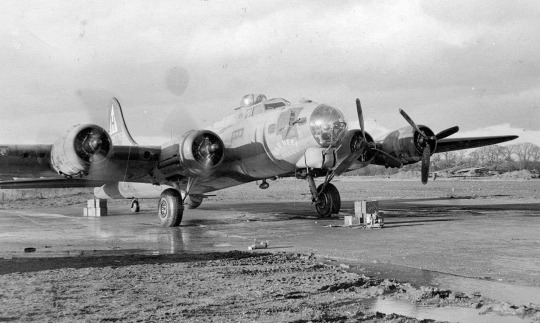
A B-17G of the 306th Bomb Group, fitted with a chin turret, from a photograph dated November 1943. The original caption read: “The new chin turret — so-called because it is fitted under the ‘chin’ of the aircraft — is the latest addition to the armor of the Flying Fortress.” United States Army Air Forces

A gunner sights his machine gun through the Plexiglass hood that was introduced over the radio compartment in the upper fuselage, amidships on the B-17, in a photo dated September 1944. Photo by PhotoQuest/Getty Images
The top turret and ball turret were electro-hydraulically powered and could bring the guns to bear on a target rapidly, traversing at some 50 degrees per second and electrically fed with ammunition. The tail turret was manually operated while the remaining trainable guns were on pivoted mounts, meaning the gunners had a limited field of fire and had to wrestle with the slipstream as they tried to get the enemy in their sights. Those sights were initially of the primitive ring-and-bead type, later superseded by reflector sights, making deflection shooting more reliable.
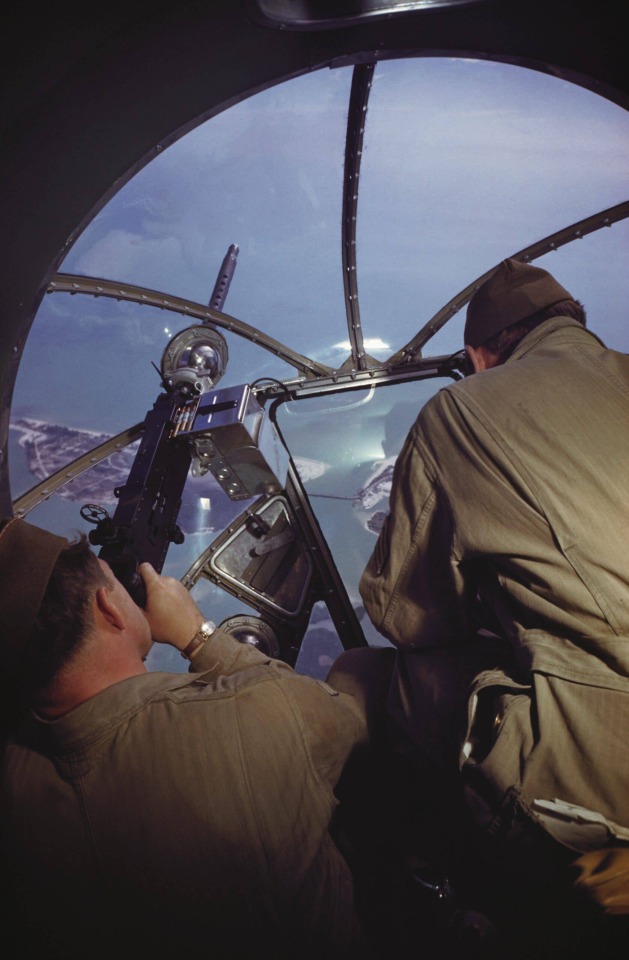
Bomber crew in the nose of a B-17 in the run-up to World War II. The limited traverse available on the gun mounted in the nose transparency is evident. Photo by Ivan Dmitri/Michael Ochs Archives/Getty Images
Despite the impressive concentration of firepower, an individual bomber remained highly exposed, especially during its run-in to the target, when it needed to fly straight and level.
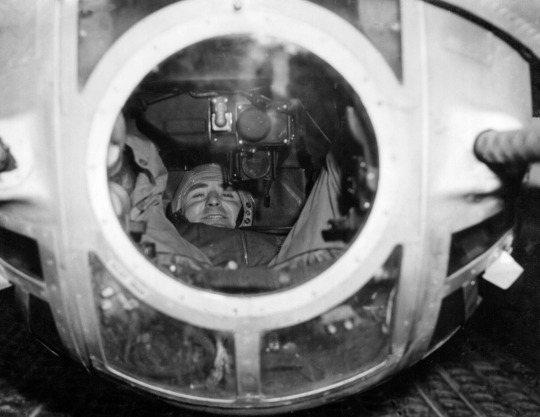
A gunner sitting at his action station in a B-17 ball turret, September 1944. Photo by Mondadori via Getty Images
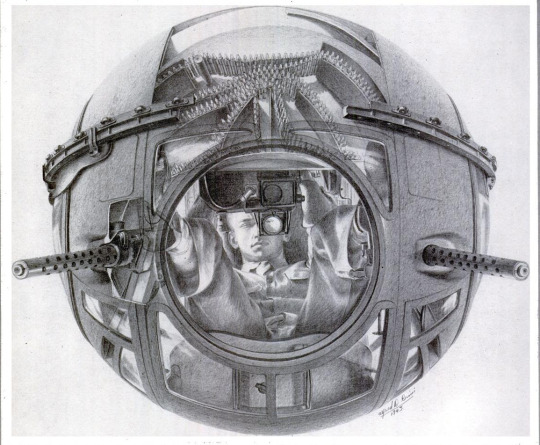
A wartime illustration of a Sperry Ball Turret, of the kind that armed versions of both the B-17 and B-24. The foetal position of the gunner and the ammunition feed mechanism are seen to good effect. Alfred D. Crimi, illustration for United States Army
The combat box was therefore soon developed to provide mutual protection, with interlocking arcs of fire provided by bombers flying in formation and staggered at different levels. This presented Luftwaffe fighters with a bigger problem and helped ensure that bombs were delivered close to the chosen target. This latter point was especially important bearing in mind the high altitudes from which these raids were typically flown. However, these tactics also required the bombers to stay in rigid formation if it was to be successful — counterintuitive when coming under attack from fighters or anti-aircraft fire from the ground.
Ultimately, as formations grew in size, the combat box was refined to become the ‘wing box,’ comprising three staggered 18-plane boxes for a total of 54 bombers. This was especially challenging for crews, with closely packed bombers running into each other’s turbulence and with a risk of bombs from a higher stack hitting aircraft flying below. When it worked, however, the wing box provided roughly 700 defensive machine guns that could be brought to bear on fighter opposition.

The view into a multi-ship B-17 bomber stream during World War II. These examples are purportedly from the 493rd Bomb Group, 3rd Bomb Division. U.S. Air Force photo
As well as falling bombs, there remained the risk of fratricide of another kind, too. While bombers’ gun turrets were designed to fire on arcs that ensured the aircraft’s tail, for example, would not be shot off, the same was not the case for other bombers flying nearby.
Other changes to the combat box tactics followed, including looser formations of 27 or 36 aircraft once flak superseded fighters as the primary threat to the bombers. The need for more spacing was driven by the fact that the detonation of a single anti-aircraft shell from a flak gun could potentially knock out more than one bomber. Once radar-guided Pathfinder groups became available, this also allowed bombers to operate with greater separation between them and still hit their target reasonably accurately, even in poor weather.

A B-17 crew of the 306th Bomb Group stand underneath the flak-damaged wing of their B-17, nicknamed Holy Hellcat, in 1943. United States Army Air Forces
Whatever the tactics, the process of getting bombers into compact formation was also far from easy. Considerable training was required beforehand and, for the missions themselves, assembling the bombers in their boxes needed a lot of time and energy on the part of the crews and consumed precious fuel. Some accounts suggested it took roughly an hour to get into formation at the start of a mission. Flamboyantly painted ‘assembly ships’ were among the initiatives developed to make the process easier.
At the same time, the Luftwaffe was adapting its tactics to deal with larger and better-armed USAAF bomber formations. In particular, German fighter pilots made high-speed ‘slashing’ attacks.

A model of a B-17E/F with latticework showing the directions of fire from its defensive machine guns, for the aid of a Luftwaffe Fw 190 fighter pilot, circa 1943–44. German Federal Archives
Despite the lack of fighter opposition at the start of the USAAF bombing campaign, it was far from easy for the Luftwaffe to bring down a big B-17 or B-24 bomber.
One Luftwaffe report indicated that around 20 hits from 20mm cannon shells (far more destructive than the bombers’ own machine guns) were needed to destroy a USAAF heavy bomber in an attack from the rear. At the same time, the average Luftwaffe pilot would hit a bomber with only around two percent of the rounds they fired; that translated to a requirement of 1,000 20mm rounds to ensure a bomber’s destruction. A Luftwaffe Fw 190 fighter carried only 500 rounds.
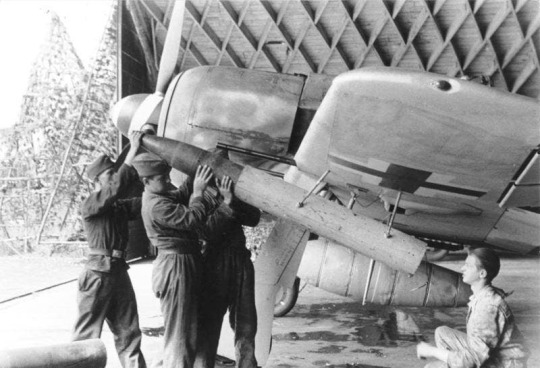
A Luftwaffe Fw 190 is loaded with 21-cm-Werfergranaten (WfG. 21) rockets, to be used to attack heavy bombers, in 1943. German Federal Archives
It’s notable, too, that as well as adding more defensive guns, the bombers also received more and improved armor, making the Luftwaffe’s task harder still.
Attacking a bomber head-on provided better odds for the Luftwaffe pilot, since the bomber’s forward-firing defensive armament was more limited, and its armor less effective. Destroying a bomber from head-on could be achieved with four or five 20mm hits, according to Luftwaffe studies. However, this was also addressed in the program to up-arm the USAAF ‘heavies,’ including the B-17’s chin turret.
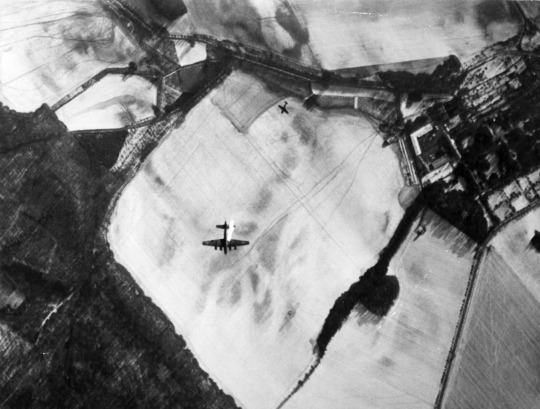
A Focke-Wulf Fw 190 shoots down a USAAF B-17G during an attack on the AGO Flugzeugwerke Aircraft factory at Oschersleben, Germany, January 11, 1944. U.S. Air Force photo
Once again, as the USAAF bombers added guns, the Luftwaffe in turn increased its firepower, adding more ammunition, cannons in ever-heavier calibers, and later even air-to-air rockets. These initiatives may have been driven primarily by the requirement for heavy-hitting weapons that would be more likely to destroy a heavy bomber in a single pass, but they also increasingly out-ranged the bombers’ defensive guns. Fortunately for the Eight Air Force, the 21-cm rocket, despite its large warhead, was less than reliable.
In action, the 21-cm-Werfergranaten (WfG. 21) rocket proved relatively ineffective. “It downed few bombers, but it often damaged planes sufficiently to force them out of formation so that other fighters could finish them off,” the aviation historian Alfred Price recalled.
In October 1943, an Eighth Air Force raid against the ball-bearing production center at Schweinfurt, in southern Germany, demonstrated to USAAF leadership that a different approach would be needed if the bombers were to survive.
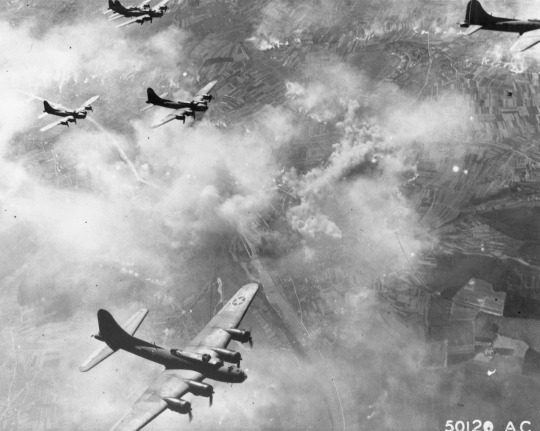
USAAF B-17Fs in formation over Schweinfurt, Germany, during an earlier raid on the ball-bearing production center on August 17, 1943. U.S. Air Force photo
By this stage, fighter escorts were available to the USAAF bombers, but, as the Schweinfurt raid of October 14, 1943, demonstrated these protective assets were too few in number and their range too short to ensure adequate protection.
The second Schweinfurt raid saw 291 B-17s sent against the target, of which 60 were lost outright, 17 damaged beyond repair, and another 121 damaged to one degree or another. A staggering 22 percent of the bomber crews involved — around 650 out of 2,900 men — were killed.

A B-17 of the Eighth Air Force heads back from the raid against Schweinfurt, Germany, on October 14, 1943, an operation that came to be known as known as ‘Black Thursday.’ U.S. Air Force photo
The USAAF responded by suspending unescorted daylight bomber raids deep into Germany until February 1944. When they recommenced, P-51B long-range escort fighters were available to provide the bombers with the close defensive protection they so badly needed. Flying ahead of the combat boxes, the P-51s would ultimately wrest control of the skies from the Luftwaffe’s fighter force. They would be aided in this by the tide of the war turning against Germany more generally, depriving it of the resources it needed to try and blunt the Allied bomber offensive.
Between February and June 1944, this combination of factors finally saw the B-17 emerge as a survivable asset. After the successful ‘Big Week’ raids of early 1944, Berlin was now in the USAAF’s sights. The first Eighth Air Force raid on the capital of the Third Reich came in March.
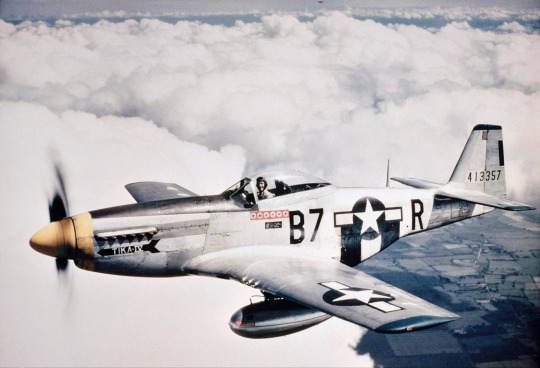
Tika IV, a P-51D flown by Lt. Vernon Richards, serving with the 374th Fighter Squadron, 361st Fighter Group. United States Army Air Force/361st FG Association, via Al Richards
The Luftwaffe’s response, from now on, was fairly tokenistic. The jet-powered Me 262, armed with heavy cannons and also rockets, was a formidable bomber-destroyer but fielded in numbers too small to be meaningful and its operations were hampered by shortages of pilots and fuel. The rocket-powered Me 163, on the other hand, offered blistering performance that allowed it to pass through bomber streams unscathed, but was arguably more lethal for its pilots than the Eighth Air Force.
Until the Eighth Air Force finally got the upper hand over Europe, survival had very much been down to the bravery and skill of the bomber crews themselves. While they were aided by the ability of the B-17, especially, to absorb a significant degree of battle damage, their machine gun armament was more than just a morale-booster.

“Hitler would like this man to go home and forget about the war. A good American non-com at the side machine gun of a huge B-17 bomber is a man who knows his business and works hard at it” — the original caption of a staged wartime propaganda photo showing a B-17 waist gunner. Collection Library of Congress, Transfer from U.S. Office of War Information, 1944
The bombers’ defensive armament and the tactics designed to best exploit it forced the Luftwaffe to change its approach. Gunners also achieved success, with the Eighth Air Force claiming 6,259 enemy aircraft destroyed by bomber gunners, more than for its fighter pilots. There is no doubt, however, that attributing fighter ‘kills’ was tricky in the heat of combat. Often, multiple gunners would open fire on the same target, observation of confirmed wreckage was far from guaranteed, and there was no gun-camera footage. Limited recognition of gunner aces reflected these realities, but at the same time, their enlisted status (for the most part), meant they were often also omitted from official lists of USAAF aces.

B-17s from the 398th Bombardment Group fly a bombing run to Neumunster, Germany, on April 13, 1945, less than one month before the German surrender on May 8. U.S. Air Force photo
Regardless, their job was a vital one and their mission among the most hazardous imaginable.
“When he was not shooting or being shot at, the gunner’s prime concern was survival,” Bruce D. Callander wrote in the April 1, 1991, issue of Air & Space Magazine.
“Missions lasted up to eight hours, with much of the flying taking place above 25,000 feet. Temperatures dropped as low as minus 60 degrees Fahrenheit in bombers that had no insulation and little heating outside the flight deck. Fleece-lined flight jackets were scant protection. The earliest electrically heated suits often shorted out and burned their occupants. Waist gunners worked through open windows, suffered frozen fingers, and slipped on the spent shells that piled up at their feet. Turret gunners had slightly more protection from the elements, but their cocoons allowed little room to move an aching arm or to stamp a cold foot.”
With hindsight, it’s clear that the availability of high-quality long-range escort fighters in sufficient numbers was the decisive factor in reducing Eighth Air Force bomber losses to a more acceptable level. But until those fighters were fielded, the bomber crews themselves more often than not provided their aircraft with the first and last line of defense.
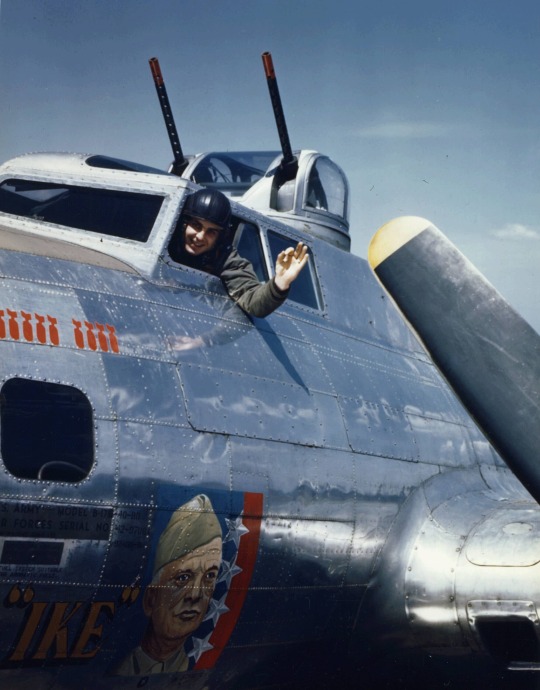
1st Lt. George H. Heilig waves and gives the okay sign from the cockpit of the General Ike, a B-17 from the 401st Bomb Squadron, 91st Bomb Group, Eighth Air Force, England, circa 1944. Photo by PhotoQuest/Getty Images
Interestingly, there was a school of thought in the United Kingdom, at least, that suggested that the Royal Air Force might have been better off removing defensive guns from its World War II bombers altogether.
The theoretical physicist and mathematician Freeman Dyson, in 1943, proposed removing at least some of the gun turrets from Lancaster bombers, to provide what he claimed would be a 50 m.p.h. increase in cruising speed. The unarmed Mosquito relied on its speed for protection from Luftwaffe fighters, but it was a far higher-performing aircraft in general and it seems highly unlikely that an unarmed Lancaster would have been much more survivable.
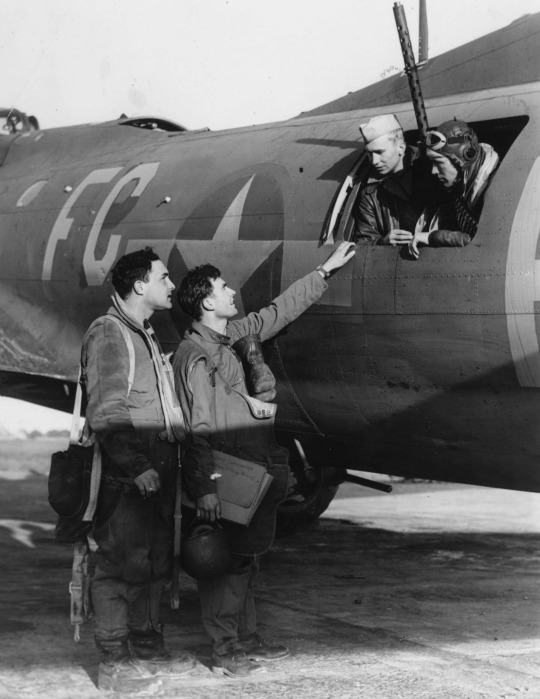
August 1943: United States Army Air Forces bomber crewmen with their B-17. Visible are the left-side waist machine gun, as well as the ball turret and the gun protruding from the radio compartment in the upper fuselage. Photo by Hulton Archive/Getty Images
This brings us again to the morale factor and the very important fact that USAAF and Royal Air Force heavy bomber crews were able to fight back with defensive armament, even if their guns were still at a disadvantage against the Luftwaffe in terms of destructive power.
While precise tallies of the Eighth Air Force gunners’ successes can never be determined, their legacy was continued in the postwar U.S. Air Force, which continued to arm its strategic bombers with guns, finally only in the tail, right up until the B-52H. The B-52H still serves today, albeit with its tailguns now deleted. Fittingly, the B-52 and the service’s other strategic bombers come under the command of the Eighth Air Force — the very same formation whose gunners fought so valiantly for the liberation of Europe back in World War II.
Contact the author: [email protected]
40 notes
·
View notes
Text
Spesifikasi PC untuk Game Virtual Girl @ World’s End
Spesifikasi PC untuk Game Virtual Girl @ World’s End Spesifikasi PC untuk Game Virtual Girl @ World’s End - Prontt.com, Bushiroad Games dan HEADLOCK telah mengumumkan Spesifikasi PC dan peluncuran game visual novel Virtual Girl @ World’s End pada 12 Juni 2025. Virtual Girl @ World’s End adalah game visual novel berlatar kota Tokyo tahun 2055 yang mencekam akibat perang dan juga krisis sumber daya. Game ini menceritakan perjuangan seorang gadis bernama Ai yang menjadi penyelamat melalui siarannya. Ai merupakan anggota Vstar, menyanyikan lagu untuk memberikan harapan kepada dunia yang sedang menuju kehancuran. Virtual Girl @ World’s End menawarkan desain karakter karya Osamu Nobusawa serta pengisi suara osuara berbakat, termasuk Azusa Tachibana sebagai Ai. Game ini menjanjikan pengalaman mendalam dengan cerita emosional dan juga desain dunia yang memikat, cocok bagi penggemar visual novel. Virtual Girl @ World’s End tersedia untuk Nintendo Switch dan juga PC melalui Steam, dengan harga 3.960 yen atau sekitar Rp400 ribu. Selain itu, edisi “Limited Box” seharga 19.800 yen (sekitar Rp2 juta) mencakup game, soundtrack, dan juga aksesori spesial seperti sarung bantal karakter. Spesifikasi PC Virtual Girl @ World’s End [year] [caption id="attachment_33931" align="aligncenter" width="1200"] Spesifikasi PC untuk Game Virtual Girl @ World’s End - Prontt.com[/caption] Berikut spesifikasi lengkap untuk memainkan game Virtual Girl @ World’s End: Spesifikasi Minimum OS: Windows 10 64bit / Windows 11 Processor: Core i3-540 3.06GHz and higher Memory: 8 GB RAM Graphics: 1280×720 and higher(16:9) DX: Version 10 Network: Broadband Internet connection Storage: 5 GB available space Sound Card: Sound card compatible with DirectSound Additional Notes: Internet connection required https://www.youtube.com/watch?v=rjOVXUAgYQg Spesifikasi Rekomendasi OS: Windows 10 64bit / Windows 11 Processor: Core i5-750S 2.40GHz and higher Memory: 8 GB RAM Graphics: 1920×1080 and higher(16:9) DX: Version 10 Network: Broadband Internet connection Storage: 5 GB available space Sound Card: Sound card compatible with DirectSound Additional Notes: Internet connection required Virtual Girl @ World’s End akan rilis untuk Nintendo Switch dan juga PC (Steam) pada 11 Juni 2025.(***) https://prontt.com/spesifikasi-pc-untuk-game-virtual-girl-worlds-end/
0 notes
Text
1Measurement In CM dimension Shoulder(cm) Bust(cm) Physique Size(cm) Sleeve(cm) S 55 110 68 49 M 56 114 70 50 L 57 118 72 51 XL 58 120 73 52 XXL 59 122 74 53 PLEASE NOTE:1.Please in accordance your personal measurements to decide on your appropriate dimension.2.That is Asian dimension,Please see the Measurement chart Information to seek out the proper dimension.3. About Measurement:Measurement could also be 3cm/1 inch inaccuracy because of hand measure. These measurements are meant as a information that can assist you choose the proper dimension. Please take your personal measurements and select your dimension accordingly.4.Please word that slight colour distinction needs to be acceptable because of the gentle and display screen. [caption id="attachment_10673" align="aligncenter" width="800"] Cow Print Hoodies - Autumn Winter Kawaii Milk Oversized Sweatshirt[/caption] [caption id="attachment_10674" align="aligncenter" width="800"] Cow Print Hoodies - Autumn Winter Kawaii Milk Oversized Sweatshirt[/caption] [caption id="attachment_10675" align="aligncenter" width="800"] Cow Print Hoodies - Autumn Winter Kawaii Milk Oversized Sweatshirt[/caption] [caption id="attachment_10676" align="aligncenter" width="800"] Cow Print Hoodies - Autumn Winter Kawaii Milk Oversized Sweatshirt[/caption] [caption id="attachment_10677" align="aligncenter" width="750"] Cow Print Hoodies - Autumn Winter Kawaii Milk Oversized Sweatshirt[/caption] [caption id="attachment_10678" align="aligncenter" width="800"] Cow Print Hoodies - Autumn Winter Kawaii Milk Oversized Sweatshirt[/caption] [caption id="attachment_10679" align="aligncenter" width="800"] Cow Print Hoodies - Autumn Winter Kawaii Milk Oversized Sweatshirt[/caption] [caption id="attachment_10680" align="aligncenter" width="750"] Cow Print Hoodies - Autumn Winter Kawaii Milk Oversized Sweatshirt[/caption] [caption id="attachment_10681" align="aligncenter" width="750"] Cow Print Hoodies - Autumn Winter Kawaii Milk Oversized Sweatshirt[/caption] [caption id="attachment_10682" align="aligncenter" width="750"] Cow Print Hoodies - Autumn Winter Kawaii Milk Oversized Sweatshirt[/caption] [caption id="attachment_10683" align="aligncenter" width="750"] Cow Print Hoodies - Autumn Winter Kawaii Milk Oversized Sweatshirt[/caption]
0 notes
Photo





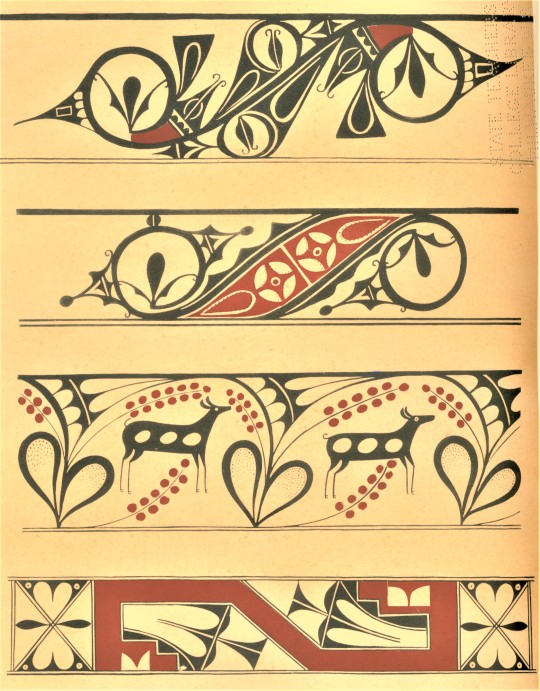
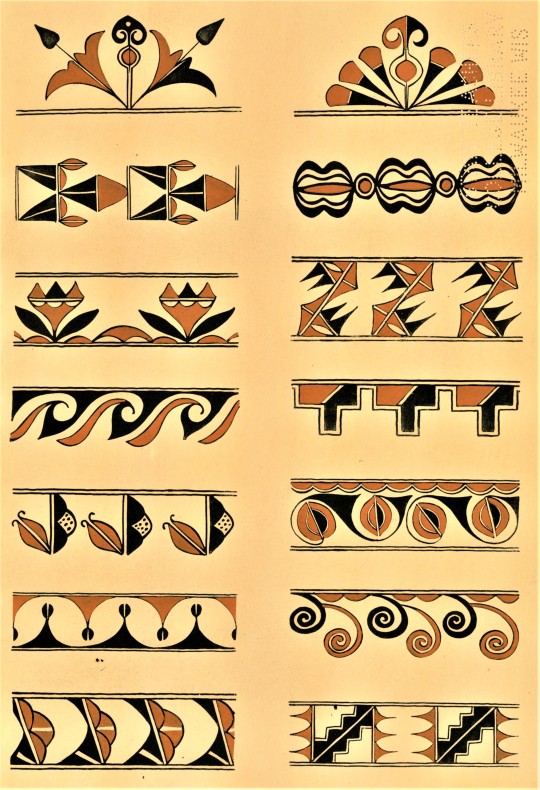
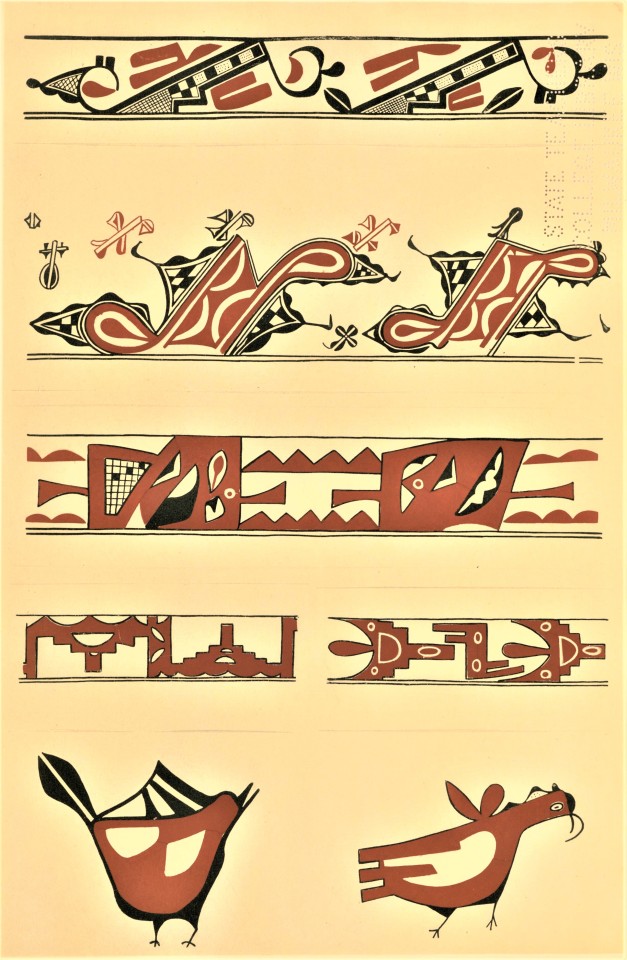


Decorative Sunday
A few weeks ago, our graduate intern Olivia introduced us to the decorative-arts publishing of the somewhat hazy figure of C. Szwedzicki. In that post, Olivia noted that C. Szwedzicki produced 6 titles on Native American Art, the publishing of which was interrupted when the Nice, France, business was seized, either by German Nazis or French Pétainists, and Szwedzicki was shipped off to Poland. Szwedzicki survived the war, and the work on this series was resumed, beginning in 1950.
Today we are showing some plates from one of the titles in that series, the 2-volume Pueblo Indian Pottery by Kenneth M. Chapman, curator of the Indian Arts Fund and the Laboratory of Anthropology in Santa Fe, New Mexico, and published in by Szwedzicki in Nice from 1933 to 1936 in an edition of 750 numbered copies signed by the publisher. The volumes include 50 hand-colored photolithographs drawn by Kenneth Chapman himself after vessels in the collection of the Indian Arts Fund at the Laboratory of Anthropology. The text is in both English and French. Volume I focuses on Taos, Picuris, San Juan, Santa Clara, San Ildefonso, Tesuque, Cochiti, Santo Domingo, and Santa Ana, while Volume II surveys Zia, Acoma, Zuni, and Hopi.
Click on the images to view the captions. If that fails, see the list of plates below the “Keep reading” prompt.
See more of our Decorative Sunday posts here.
The images from top to bottom are:
1.) Acoma water jar, ca 1875-1925. Diameter 11 in./28 cm. 2.) Title page from volume 1. 3.) Conventional bird design from the interior of a food bowl, Sikyatki, Arizona, ca. 1500. 4.) Group of designs from Zuni pottery. 5.) Group of bird designs from Acoma pottery. 6.) Group of designs from antique Zia pottery. 7.) Typical designs from antique San Ildefonso pottery. 8.) Typical designs from antique Santa Ana pottery. 9.) Group of designs from antique and modern Hopi ware. 10.) Acoma bowl, ca. 1875. Diameter 18 in./46 cm.
#Decorative Sunday#decorative arts#decorative plates#Pueblo Indian Pottery#Pueblo Indians#decorative designs#C. Szwedzicki#Kenneth M. Chapman#Indian Arts Fund#Laboratory of Anthropology#photolithographs#lithographs#hand-colored plates
172 notes
·
View notes
Text
Pekan from the Cascades:


Pekan (the forest-dwelling mustelid commonly known as the “fisher”) were apparently extinct in Washington State until reintroduction programs in the past 15 years.
Headline from November 2020:


Excerpt:
Nine months after listing the interior fisher population as endangered, the B.C. government has approved winter trapping of the elusive forest animal even though a scientist warns it could wipe out fishers in some areas. “A red-listed population of this size, with a negative population growth rate … should not be trapped,” biologist Larry Davis, a member of the B.C. fisher working group, told The Narwhal. “These animals are a low-density species. So many areas have been impacted by [forest] harvesting and fires that removing even a few more animals from these areas will probably result in local extirpations.” [...] B.C. has no endangered species legislation, allowing species at risk of extinction to be killed outside of protected areas. Out of 1,336 species at risk currently recognized by the province, only four are legally protected under B.C.’s Wildlife Act — the burrowing owl, American white pelican, Vancouver Island marmot and sea otter. B.C.’s hunting and trapping regulations for 2020-2022, which came into effect on July 1 [2020], noted the interior fisher was red-listed earlier this year [...]. The regulations said fisher trapping seasons were under review and could be amended prior to the start of trapping season on Nov. 1, but no changes have been made. [...]
The interior fisher population has suffered steep declines, largely due to habitat destruction as a result of accelerated logging for the mountain pine beetle, which has eliminated fisher denning trees such as cottonwoods and balsam poplars.
Only 300 to 500 interior fishers remain, according to Davis. [...]
Headline, image, caption, and this text excerpt published by: Sarah Cox. “B.C. government gives okay to trap endangered fishers for fur as scientists warn of impending extinctions.” The Narwhal. 20 November 2020.
-------
The province of BC hosts two kinds of fisher. The “Pacific fisher”, from temperate rainforest landscapes along the coast, has long been considered a unique and endangered subspecies/population. And the “interior” population of fishers, which the province of BC recently acknowledged as endangered, lives within the distribution range of the subspecies/population known as Pekania pennanti columbiana. On this map, in purple:

Some (many?) contemporary biologists no longer recognize the 3 subspecies of fisher, preferring to see them all as part of one undifferentiated species. Regardless, even in these cases, the “Pacific fisher” is still considered a distinct/unique population segment. (The climatically mild and wet temperate rainforest of the Pacific coast provides a much different habitat compared to fishers living farther to the east in boreal forest and Great Lakes-St. Lawrence mixed forests.)
Another excerpt:
The fisher is a specialized forest carnivore related to weasels and otters that is associated with mature and old-growth forests. Historic trapping for the animal’s valuable pelt, timber harvest, loss of an important prey item (porcupine), urban development, and other factors have severely reduced the fisher’s range across the United States. In the eastern United States, the fisher recovered much of its range after [...] regrowth of forest from abandoned farmlands, and reintroductions. In the western United States, however, the [...] ‘distinct population segment’ (hereafter referred to as the “Pacific fisher”) has not re-inhabited the majority of its former range, despite the cessation of legal trapping in the 1930s and 1940s. [...] The Pacific fisher in the United States is reduced to one small reintroduced population in southern Oregon near Crater Lake, and two small, isolated native populations in California: one in northwestern California-southwestern Oregon (in the North Coast Range and Klamath region) numbering at most 750 animals, and another in the southern Sierra Nevada numbering at most 360 individuals. [...] Moreover, the two remnant populations are separated by approximately 430 kilometers, which greatly exceeds the maximum dispersal distance ever recorded for a fisher [...]. Finally, due to the extinction of the Pacific fisher from Washington and most of Oregon, the three small populations in California and southern Oregon are themselves completely isolated from populations in British Columbia.
Text from: Center for Biological Diversity. A Petition to list the Pacific fisher (Martes pennanti) as an Endangered or Threatened Species under the California Endangered Species Act. 2008.
-------
Since the filing of this petition (2008), fishers have been reintroduced in the Cascades of Washington State.

A Pacific fisher:

A fisher from the distinct “interior” population segment, in the Selkirk region (where political borders of BC, Idaho, and Washington meet):

#love these creatures#went to a lecture at North Cascades National Park about fisher reintroduction in the Cascades and saw a lot of video footage of them
154 notes
·
View notes
Photo
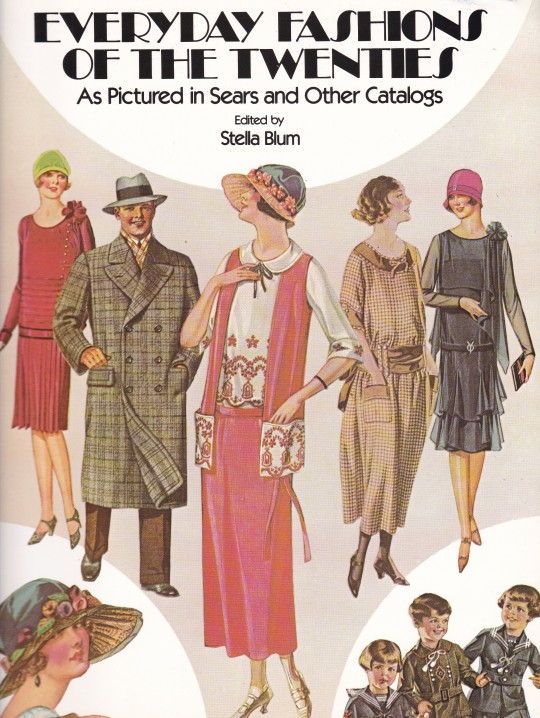



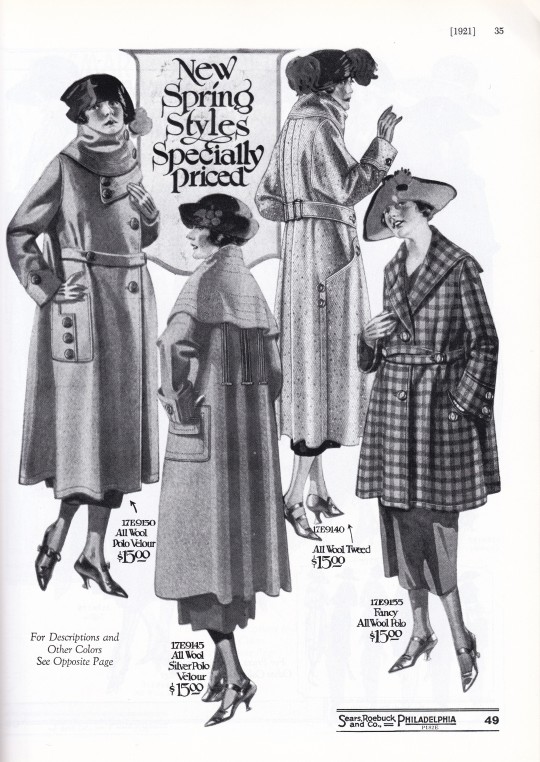





Everyday Fashions of the Twenties
Edited by Stella Blum
Dover Publication, Mineola 1981, 160 pages, 22.86 x 0.91 x 30.33 cm, ISBN 9780486241340,
euro 20,00
email if you want to buy [email protected]
The Roaring Twenties, age of jazz and flappers, Model T Fords and Hollywood movie stars, was also a time when for millions the bulky catalogs of Montgomery Ward or Sears, Roebuck were a substitute for the window displays of Paris or New York fashion shops. Buying clothing through the mails had become an American institution, and entire families were often dressed via the U.S. Post Office. More conservative than the up-to-the-minute fashion shops, mail-order catalogs nevertheless offered surprisingly much of the haute couture. But, above all, they accurately record what men, women, and children were actually wearing in the 1920s. Now Stella Blum (Curator of the Costume Institute at the Metropolitan Museum of Art, New York) has distilled into this volume the essence of the fashion pages of the Sears, Roebuck and other mail-order catalogs of the Twenties. Her informative text and selection of over 150 representative catalog pages — comprising over 750 illustrations with original captions — gradually trace the evolution of dress modes from the vogue of stodgy postwar fashions to the impact on costume of the crash of '29. In a year-by-year survey, Mrs. Blum's introductory texts relate the trends in fashion to the social changes of the dynamic and restless era, assessing the influence of war and technological developments on the high hemlines, flattened busts and hips, geometric patterns and "bobbed" hairstyles of the boyish flapper look. And as she notes, it was through the Sears catalogs that Parisian designers like Coco Chanel, Jeanne Lanvin, and Madeleine Vionnet made their influence felt on Midwestern farms and in urban ghettos. You'll find here a marvelous panorama of "smart," "modish," "chic," "stylish," and "ultra fashionable" apparel, as well as more traditional garments: for women and "misses" there are Middy blouses, Russian boots modeled by Gloria Swanson, "Bob" hats modeled by Clara Bow and Joan Crawford; coats, suits, dresses (including the first maternity dresses), sweaters, capes; silk and rayon stockings, corsets, chemises, camisoles, negligees; and accessories like necklaces, belts, combs, headbands, umbrellas, gloves, compacts, hand bags, wristwatches, and powderpuff cases. You'll see slower-to-change men's fashions — shirts, ties, suits, sweaters, and sports clothes — become trimmer, brighter, smarter. And you can follow the trends in children's fashions as well. For historians of costume, nostalgia buffs, and casual browsers, these pages afford a rare picture — unspoiled by recent myths about the Roaring Twenties — of how average people really dressed in the jazz age.
19/02/21
orders to: [email protected]
ordini a: [email protected]
twitter: @fashionbooksmi
instagram: fashionbooksmilano, designbooksmilano tumblr: fashionbooksmilano, designbooksmilano
#Fashions Twenties#anni venti#moda anni venti#Sears catalogs#roaring twenties#jazz age#fashion history#fashion books#fashionbooksmilano
50 notes
·
View notes
Text
Review: CATWOMAN 80TH ANNIVERSARY 100-PAGE SUPER SPECTACULAR
[Editor’s Note: This review may contain spoilers]
Writers: Paul Dini, Ann Nocenti, Tom King, Jeff Parker, Liam Sharp, Mindy Newell, Chuck Dixon, Will Pfeifer, Ram V, Ed Brubaker
Artists: Emanuela Lupacchino, Mick Gray, Robson Rocha, Daniel Henriques, Mikel Janin, Jonathan Case, Liam Sharp, Lee Garbett, Kelley Jones, Danny Miki, Pia Guerra, Fernando Blanco, Cameron Stewart
Colours: Laura Allred, Alejandro Sanchez, Jordie Bellaire, Jonathan Chase, Liam Sharp, Alex Sinclair, Steve Oliff, John Kalisz, FCO Plascencia, Cameron Stewart
Letters: Wes Abbott, Saida Temofonte, Clayton Cowles, Jonathan Chase, Tom Napolitano, Tom Orzechowski, Steve Wands, Gabriela Downie, Cameron Stewart
Reviewed By: Derek McNeil
Summary
Catwoman 80th Anniversary 100-Page Super Spectacular: Our gal Catwoman is turning 80 next year (and looking very good, if we meow say), and DC is celebrating with nothing less than with a huge soiree, invite only, packed with creators who mean the most to her and to whom she means the most! Stories featured in this 100-page spectacular include a tail-sorry, tale-that takes place at the end of the Brubaker/Stewart Catwoman run, in honor of artist Darwyn Cooke. Plus, Catwoman is caught by an exotic cat collector, runs into a wannabe thief trying to prove himself as her apprentice, encounters a mystery involving memorabilia from alternate continuities, and of course some Bat/Cat fun.
Positives
In Scott Snyder’s final issue of Justice League, the League set off on an epic battle to “give reckoning to every story, every event throughout history. The ones you know… and the ones you do not”. The implication seems to be that all iterations of DCU continuity through the matters. Everything matters.
This Catwoman 80th Anniversary exemplifies that theme beautifully, presenting us with stories with various different versions of Catwoman as she’s been presented through her history. The current canon version of Catwoman appears, as does the dominatrix prostitute version from Batman: Year One. Even the Catwoman as played by Julie Newmar in the 1966 Batman TV show appears. If you included the pin-ups scattered throughout the issue, just about every version of Catwoman is represented.
As often happens with an anthology book, the stories are not all equal in quality. However, there are no clunkers. Each is at least an entertaining read. However, a few of the stories stick out as especially good ones.
Positives Cont.
“Little Bird” by Mindy Newell and Lee Garbett is a touching story. Years ago, one of Selina’s foster mothers wanted to pass on a Mezuzah onto Selina some day. When Selina sees that it is now on display, Selina makes sure it is returned to its rightful owner. This story shows that even Frank Miller’s street-hardened version of Catwoman has a tender side. She has some treasure pleasant memories in her childhood, even if it was mostly terrible.
Another interesting story by Will Pfeifer and Pia Guerra places a disoriented Selina at a mysterious Bat-Con. This is an odd comic convention where the characters themselves appear to sign autographs or hold panels where fans can directly question them.
There are even some moments of “leaning on the fourth wall” that refer to the Catwoman 80th Anniversary special itself. The special’s cover is visible in one panel as a poster. Also, the “current story line” is referred to as “the one that ends in a couple of pages?”. And it even refers to Tom King’s story in the special when a fan mentions, “I hear she gets pregnant again. And this time the dad is you know who”.
Positives Cont.
Speaking of which, “Helena” by Tom King and Mikel Janin is the real gem of the issue. King’s Batman Annual #2 from 2017 showed vignettes from the romance between the Bat and the Cat over the years, even into the future. However, this story focuses in on their daughter, starting with the discovery of Selena’s pregnancy.
This story show Selena struggling with impending motherhood. Like a cat, Selena is a free spirit and hates to be tied down. However, she feels that a child will do exactly that. However, anyone who knows cats, will also know how strong the maternal instinct is. Selena comes to accept her daughter, happily accepting her new role as a mother.
In an epilogue set after Bruce’s death, Selena is telling her grown daughter that she takes after her father. It’s a touching story of how Selena overcomes her uncertainty and comes to treasure her baby daughter. This sweet tale makes me eager to read Tom King’s upcoming Batman/Catwoman maxi-series.
Negatives
In my review for The Flash #750, I voiced some concern about the overuse of the decade variant covers. These covers are truly beautiful to behold, but it is pretty unfair to completionist fans to do this with a book that already has a hefty cover price. And if you want a full set of covers, that’s ten times the cost.
It was bad enough to do this once a month for several months in a row. But now, thanks to the recent upheavals in DC’s release schedule, the Catwoman, Joker, and Green Lantern anniversary specials are all coming out in a single month. I suppose I should be glad that at least DC isn’t bringing them all out on the same week. But please, DC, could you put a moratorium on these decade variants for a few months? My wallet needs time to recover from the beating it’s receiving this month.
#gallery-0-4 { margin: auto; } #gallery-0-4 .gallery-item { float: left; margin-top: 10px; text-align: center; width: 25%; } #gallery-0-4 img { border: 2px solid #cfcfcf; } #gallery-0-4 .gallery-caption { margin-left: 0; } /* see gallery_shortcode() in wp-includes/media.php */
1940s Cover
1950s Cover
1960s Cover
1970s Cover
1980s Cover
1990s Cover
2000s Cover
2010s Cover
Verdict
The Catwoman 80th Anniversary 100-Page Super Spectacular is a fine collection of Catwoman stories. This special revisits many eras’ interpretations of the character, bringing them back to life, proving that ever story does indeed matter.
Review: Catwoman 80th Anniversary 100-Page Super Spectacular Review: CATWOMAN 80TH ANNIVERSARY 100-PAGE SUPER SPECTACULAR Writers: Paul Dini, Ann Nocenti, Tom King…
#alejandro sanchez#Alex Sinclair#Ann Nocenti#Batman#Bruce Wayne#Cameron Stewart#Catwoman#Chuck Dixon#Clayface#clayton cowles#Daniel Henriques#Danny Miki#DC comics news#DC Comics News Reviews#DCN Reviews#Doctor Destiny#Ed Brubaker#Emanuela Lupacchino#FCO Plascencia#Fernando Blanco#Gabriela Downie#Helena Wayne#Jeff Parker#John Kalisz#joker#jonathan case#Jordie Bellaire#Kelley Jones#Laura Allred#Lee Garbett
7 notes
·
View notes
Text

#caption#original caption#celeb caption#emma watson caption#realization caption#no no caption#sneak caption#exposed caption#breasts caption#curves caption#figure caption#hrt caption#growth caption#permanent caption#acceptance caption#feminization caption#100 notes#100 note caption#100 note emma watson#250 notes#250 note caption#250 note emma watson#500 notes#500 note caption#500 note emma watson#750 notes#750 note caption#750 note emma watson#1000 notes#1000 note emma watson
1K notes
·
View notes
Text
Vous cherchez un moyen de faire un faux fichier PDF ? Alors, vous êtes au bon endroit. Quelle que soit la raison pour laquelle vous souhaitez corrompre un fichier PDF, vous pouvez vous référer à ce guide. Ici, dans cet article, vous apprendrez comment vous pouvez envoyer un faux PDF qui ne s’ouvre pas et, comment vous pouvez protéger un fichier PDF avec facilité. Pourquoi faire un faux PDF ? Cela pose alors une question: pourquoi faire un faux PDF ? Pour ce genre de questions, il y a deux réponses qui semblent nous arriver assez rapidement en tête. La première, c‘est une question qui va toucher la sécurité. En effet, l’idée, ça pourrait par exemple être de tromper d'éventuels pirates informatiques ou personnes fouillant votre ordinateur. Ainsi, on met de faux PDF assez alléchants facilement accessibles sur son PC. [caption id="attachment_62064" align="aligncenter" width="750"] Erreur Faux PDF[/caption] Quand la personne mal intentionnée va cliquer dessus, elle va alors se retrouver dans une position pour le moins loufoque avec de faux PDF qui ne vont donc absolument pas s'ouvrir pour elle. L’idée, c‘est donc qu'elle finira pas se désintéresser surtout si plusieurs faux PDF se trouvent à peu près au même endroit et vous lâchera. Mais l’autre raison qui peut expliquer le fait de vouloir des faux PDF est bien différente. Une astuce pour gagner un peu de temps Car oui, pour certains, faire de faux PDF, c‘est avant tout une excuse qui va vous servir à gagner du temps. Cette astuce est assez commune, que ce soit auprès de vos professeurs et patrons. On vous donne une situation très basique. Votre patron ou professeur vous demande de rendre un travail pour une date. Alors que vous êtes la veille ou le jour même, votre travail est bien loin d'être fini. Vous souhaiteriez alors avoir 24h supplémentaire pour pouvoir finir et avoir une bonne note. Alors, l'astuce va être d'envoyer un faux PDF et faire cuire à votre interlocuteur que le problème vient donc de son ordinateur à lui. [caption id="attachment_62062" align="aligncenter" width="771"] Interface File Destructor 2.0[/caption] Pour cela, il existe un site tout simple, qui s'appelle File Destructor 2.0. Ce site a une interface basique, mais diablement efficace. Ici, l’idée est simple, vous entrez le type de dossier que vous voulez, son nom et sa taille. Ensuite, vous n'avez plus qu'à télécharger votre pièce jointe corrompue qui ne s’ouvrira donc jamais. Envoyez-la simplement par mail et attendez la réponse de la personne en face. Une fois que celle-ci vous aura dit que la pièce jointe ne fonctionne pas, prétexte un problème informatique et envoyez-lui votre travail fini. Les limites de la technique du faux PDF Sur le papier, cette technique du faux PDF est impeccable. Sauf que dans les faits, si la personne en face à un minimum de connaissances, elle risque de rapidement tomber à l'eau et à vous les ennuis alors. En effet, c’est par exemple une technique que l'on vous déconseille fortement d'utiliser à plusieurs reprises. Car forcément, au bout d’un moment, la personne en face de vous comprendra ce stratagème des faux PDF. De plus, il y a un élément qui peut indiquer votre tricherie à la personne en face, c‘est la taille du fichier. En effet, vous n'arriverez jamais par avance à atteindre le poids pile que vous avez envoyé à votre correspondant. Dès lors, celui-ci en comparant les deux poids pourrait comprendre qu'à minima vous avez fait des modifications sur votre fichier. C’est de cette manière qu’il comprend que même s'il y avait bien un problème, vous avez gagné du temps. Dès lors, cette technique du faux PDF, bien qu'elle soit efficace de temps en temps, n'en abusez pas sous peine que la situation se retourne complément contre vous sans que vous ne vous y attendiez. C’est encore plus vrai si la personne en face de vous l’a déjà elle-même utilisée. Protéger vos PDF à l'aide d’un code Bon maintenant que l’on a vu la raison principale pour
laquelle les gens font de faux PDF, intéressons-nous à l'autre cas qui est quand même bien plus rare, celui des gens qui le font pour protéger des fichiers. Certes, cette technique du faux PDF peut marcher, mais là encore, si la personne en face de vous est un minimum doué en informatique, elle ne va pas mettre bien longtemps a voir que quelque chose est en train de clocher. Ainsi, elle va donc souvent fouiller un peu plus en profondeur dans toute cette histoire et c’est à ce moment-là qu'elle risque de découvrir que vous avez en fait essayé de l'avoir. Sauf que vos fichiers ne sont pas protégés pour autant. Dès lors, dans ce cas de figure, ce que l'on va vous conseiller, c‘est que plutôt que de faire de faux PDF, vous devez tout simplement renforcer vos fichiers sensibles à l'aide de mots de passe. C’est assez simple et ça ne prend que quelques minutes. Voici la marche à suivre: Ouvrez le document PDF dans Acrobat DC. Allez dans Fichiers. Choisissez Protéger à l’aide d’un mot de passe. [caption id="attachment_62063" align="aligncenter" width="485"] Mettre mot de passe sur un PDF[/caption] Tapez le mot de passe et validez. Ça y est, à partir de maintenant vos fichiers PDF seront sécurisés à l'aide d’un mode de passe que seuls vous et les personnes autorisées à ouvrir le dossier connaîtront. Vous n'avez donc plus besoin de faire de faux PDF. Conclusion En résumé, faire de faux PDF, si c'est pour protéger son ordinateur, ce n'est pas le mieux. Par contre, si c'est pour arnaquer un rendu de dossier, cela peut marcher. Gardez le cependant en tête que cela pourrait s'avérer être un échec et que vous devrez en subir les conséquences.
0 notes
Text
Gordon & MacPhail unveils twin Longmorn whiskies personally selected by identical twins from the owning family
Single malt Scotch whisky creators Gordon & MacPhail is releasing two decanters as part of its ‘Private Collection’, single cask releases personally selected by members of the family that owns the company.
The ‘twin’ whiskies were selected for bottling by identical twin brothers Stuart and Richard Urquhart, and contain the oldest Longmorn single malts ever released, originally laid down to mature by the brothers’ grandfather George Urquhart in 1961.
Sold as a pair, only 97 sets of twin decanters are available worldwide with a UK recommended sales price (RSP) of £30,000.
When filling Gordon & MacPhail casks, George Urquhart always had the destiny of each cask in mind. Often keen to explore the boundaries to further his understanding, the Longmorn twin casks presented an opportunity to reveal the effects of European Oak compared to American Oak during maturation.
Both whiskies began life with inherently the same DNA. Influenced by their environment – the species of oak – the whiskies gradually evolved and now exhibit distinctly different flavour profiles.
To mark the launch, Professor David Purdie, a fellow of the Royal College of Physicians, has worked with Gordon & MacPhail to uncover what shapes character in twins – the effect of heritage, environment, and location. In two three-minute ‘twin’ films, Professor Purdie meets Gordon & MacPhail’s Director of Prestige, Stephen Rankin, to explore the subject and reveal how this parallel could be applied to twin whiskies.
Both bottled at cask strength and matured in first fill Sherry hogsheads, the whisky from Cask 508, selected by Richard Urquhart, was nurtured in European Oak. Its whisky is a mahogany colour, with red highlights and exhibits a rich, abundant nose, bursting with complex aromatic flavours and perfumed top notes.
By contrast, the whisky from Cask 512 selected by Stuart Urquhart is rich chestnut in colour, gleaming with ruby and amber highlights. Matured in American Oak, it is slightly sweeter on the nose and fruity on the palate, with notes of black cherry, raspberry, and dried vanilla.
Professor Purdie said: “Like human identical twins, both whiskies share the same make up. They were born together, but matured separately. It is remarkable to observe how the identical spirit filled into the casks all those years ago has been altered by the natural environment of the casks themselves – one crafted from European Oak and the other from American Oak. Just like twins who start life at the same time and place, each whisky has then been shaped and developed by a multitude of separate factors to create these subtle differences.”
Stuart Urquhart, Gordon & MacPhail’s Associate Director of Whisky Supply added: “As someone whose day-job is applying the family’s knowledge of how to match spirit with the perfect cask, the nuances of our Longmorns, distilled 57 years ago, were especially intriguing. The whisky I selected has a slightly spicy finish and many would attest that my sense of humour is certainly drier and spicier than that of my brother.”
Richard Urquhart, Gordon & MacPhail’s International Sales Manager for Asia & Americas, said: “For much of our lives, Stuart and I have shared similar environments, growing up together, sharing a flat while attending the same university, sailing competitively as a team and now working under the same roof. However, as we’ve grown older, got married and had children, it’s intriguing to see how our individual characters, much like the whiskies, are diverging.”
Stephen Rankin, Gordon & MacPhail’s Director of Prestige, fourth generation member of the Urquhart family and himself a father of twins, said: “This is a unique and exclusive opportunity to taste a remarkable piece of Scotland’s liquid history. Owners of these twin decanters will be able to explore the similarities and nuances of the oldest Longmorn single malt Scotch whiskies ever bottled.”
Each individually numbered hand-blown decanter is beautifully presented in award-winning packaging which includes a book written by renowned writer and rare whisky specialist, Jonny McCormick, along with a personally signed certificate of authenticity from each brother.
The twin decanters complete the release of four extremely rare single cask bottlings unveiled as part of the ‘Private Collection’ range. The first, Private Collection Glenlivet 1943 by Gordon & MacPhail, a rare wartime cask, was released in October 2017 and the second, Private Collection from Linkwood Distillery 1956 by Gordon & MacPhail, was released in February 2018.
For more information, please visit www.gordonandmacphail.com.
#GordonandMacPhail
[caption id="attachment_35083" align="aligncenter" width="750"] Decanters 508 and 512[/caption]
The post Gordon & MacPhail unveils twin Longmorn whiskies personally selected by identical twins from the owning family appeared first on GreatDrams.
from GreatDrams https://ift.tt/2CC9xZN Greg
2 notes
·
View notes
Photo

Elementary Statistics (3rd Edition) - William Navidi - eBook
Download it for: $12 only
Navidi’s Elementary Statistics, 3rd Edition (PDF) is a conceptual and procedural course in introductory statistics. It has been developed around three central themes: clarity, quality, and accuracy, based on extensive market research and feedback from statistics instructors across the country.
Excellent exercises, clear examples, author-created supplements, and completely integrated technology make this one of the more masterful elementary statistics courses available. The supplements and text are flexible enough to work effectively with a wide variety of instructor styles; for instance, the text covers both P-value and critical value approaches to hypothesis testing. Improvements to this 3rd edition include a new objective on the weighted mean, latest real data in new exercises and case studies, and a new supplement focused on prerequisite skills. Because statistics instructors universally agree that using real data better engages students, most examples and exercises in this textbook use real-life data; in fact, over 750 actual applications of statistics appear within the ebook, and topics and their pages can be found in an index. Each section contains one by one instructions explaining how to use multiple forms of technology to carry out the procedures explained in the textbook.
Several pedagogical features enhance the instructor’s and college students’ experiences:
• Marginal Explain It Again notes reinforce important concepts.
• Write About It exercises require students to explain statistical concepts in their own words.
• Each chapter begins with a discussion of a real problem that is used in the end-of-chapter Case Study.
• After each concept is explained, Check Your Understanding exercises determine whether students understand the material or need to review.
Author-provided supplements play a vital role in the educational process:
• Exercise videos, close-captioned for the hearing-impaired, are assignable in ConnectMath.
• Chapter-aligned technology manuals help students learn to use calculators, Minitab, and Excel.
• Short lecture videos introduce concepts, definitions, formulas, and problem-solving procedures.
• Editable PowerPoint presentations are broken down by learning objectives, with multiple teaching styles incorporated into each series.
• Guided student notes provide instructors the framework of daily class activities while students gain the framework of well-organized notes.
• Manuals for calculators, Excel, and Minitab 17 provide additional text-specific practice. Data sets from particular exercises are prepopulated into Minitab, TI-Graph Link, Excel, SPSS, and comma-delimited ASCII formats.
P.S. Contact us if you want Elementary Statistics, 3rd Edition Test Bank or other sources.
NOTE: The product includes the ebook, Elementary Statistics, 3rd Edition in PDF. No access codes are included.
https://duranbooks.net/shop/elementary-statistics-3rd-edition-william-navidi-ebook/
0 notes
Text
Review: THE FLASH #750
[Editor’s Note: This review may contain spoilers]
Writers: Joshua Williamson, Geoff Johns, Francis Manapul, Brian Buccellato, Marv Wolfman, Scott Lobdell
Artists: Rafa Sandoval, Stephen Segovia, Scott Kolins, Francis Manapul, Riley Rossmo, David Marquez, Brett Booth, Norm Rapmund
Colours: Arif Prianto, Michael Atiyeh, Ivan Plascencia, Alejandro Sanchez, Luis Guerrero
Letters: Steve Wands, Rob Leigh, Joshua Reed, Deron Bennett, ALW’s Troy Peteri
Reviewed By: Derek McNeil
Summary
The Flash #750: Beginning: “The Flash Age”! The story we’ve been building toward since issue #50 comes to a head! While a supercharged Speed Force wreaks havoc on Barry Allen’s life, a new threat appears on the horizon in the form of the deadly Paradox. Destined to destroy the Flash’s legacy, Paradox sends his herald, Godspeed, to trap the Flash family! Plus, in this special anniversary issue: tales from across the generations of super-speedsters by an all-star lineup of writers and artists!
Positives
In honour of the 80th Anniversary of the title, DC has reverted back to legacy numbering. Thus, The Flash #750 hits the stands this week instead of the expected 89th issue of the series. “Legacy numbering” means that if the title kept the same incremental numbering through every relaunch of the title, then the number would have naturally progressed to issue #750 with this very issue.
This covers the tenures of DC’s primary three Flashes, Jay Garrick, Barry Allen, and Wally West, and appropriately, all three are well represented in the six stories included. As the current star of the title, Barry merits three stories, while Jay and Wally each get a single, yet important story each.
This first, and main, story is the first chapter of regular series writer Josh Williamson’s “The Flash Age”. I really liked this story, as it mostly gives a break and allows us to catch up with the current status of Barry’s world and the people in it, before pushing into the next big conflict. This makes the story a nice jumping-on point for new readers as well as providing a neat wrap up of the previous story arc.
Most importantly, it shows that Barry and Iris are back together and that their relationship is as strong as ever. In fact, things seemed to be going so well, that when Iris said, “I have something to talk to you about. A surprise”, I was expecting that she might propose to Barry.
Positives Cont.
Unfortunately, this is where the impending conflict cut into the story. Godspeed interrupts this moment, taking Barry to face Paradox. Paradox then gives Barry a choice between giving up being the Flash or fighting for his life against Godspeed. This is where the story leaves off, giving us a rather effective cliffhanger to bring readers back for the rest of “The Flash Age”.
I also love that this story includes several instances of Central City’s citizens showing their gratitude to the Flash for saving their lives or helping them in other ways. It’s a nice touch for an anniversary story. Plus, it provides a nice counterpoint to Paradox’s claims that Barry has been endangering everybody by the effect his powers have had on reality itself. Hopefully, this will help Barry realize that the good he has done outweighs any damage he has caused.
In the second story, Geoff Johns bring us an interesting little tale featuring Captain Cold, set during Wally’s tenure as the DCU’s primary Flash. In this story, we see that what Wally assumes that Cold goes on a rampage for the sole purpose of infuriating Wally.
However, the story shows us that the “rampage” came about unintentionally. Cold merely stumbled into the midst of an armed robbery when shopping at his local corner store. Through a series of misunderstandings, he finds himself in the middle of a confrontation with the Keystone City Police. While this doesn’t excuse Cold for his crimes, this does show how easy it is for events to quickly get out of control for a villain in the DCU.
Positives Cont.
The next story, by Francis Manapul and Brian Buccellato features Barry examining the question of whether the Flash has to be Barry Allen. He does this by using a previously unseen power to send his consciousness through other timelines where somebody else became the Flash instead of him. In each timeline, he finds that someone admirably fills the role of the Flash. He arrives at the moral of the “Even if it doesn’t have to be me… I”m glad that it is”
However, I have to wonder why the examples of Wally and Jay aren’t enough evidence that that someone else could serve as the Flash other than Barry. I would have thought either would be proof enough to settle the question.
Marv Wolfman, the man wrote the story of Barry’s death in Crisis On Infinite Earths, returns to the character to tell of an interesting encounter between Barry and the Mirror Master. The interesting conceit of this story is that the Mirror Master’s mirrors in the story enact various transformations upon the Flash’s body. These transformations allow artist Riley Rossmo to revisit some of the bizarre transformations over the years, such as the time Abra-Kadabra turned Barry into a walking wooden puppet.
Next, regular writer Joshua Williamson gives us a story of Jay Garrick, set in the title’s inaugural year, 1940. The story centres around an encounter between Jay and the Thinker. However, the most intriguing bit of the story is when a mysterious figure, presumably the Reverse Flash, whispers in Jay’s ear, “They’ll forget you Jay Garrick. I’ve seen your future…”.
Positives Cont.
This seems to be setting up a future storyline involving Jay and the Reverse Flash, which is further borne out by the blurb at the story’s end. This blurb promises, “To be continued in The Flash in 2020″. Unfortunately, this seems to imply that we won’t see the followup immediately, but it is coming relatively shortly.
Also, I noticed that the image on that page also shows Wally and Bart. I hope this means that we will be seeing a full reunion of the Flash Family when this story continues.
Finally, the entire creative team for the Flash Forward miniseries returns to provide an epilogue to that miniseries. Writer Scott Lobdell continues where that story left off, creating a bridge between it and the upcoming Generation Zero: Gods Among Us and subsequent Generation One to Five specials.
While little is known about this upcoming event, it has been speculated that it will involve a major shift in DCU continuity. That speculation seems to be borne out in this story, where Wally, now wielding the power and knowledge of the Mobius Chair, exams the current state of the DC Universe’s continuity.
It has been my theory for a while now that the time itself is unravelling in the DC Universe, and this story confirms that. Wally looks through his own personal timeline and sees that multiple contradictory events seem to concurrently exist in the current continuity. The original Silver Age origin of the Teen Titans happened as Wally remembers it, but the New 52 Teen Titans also exist as the first group to call themselves by that name.
#gallery-0-4 { margin: auto; } #gallery-0-4 .gallery-item { float: left; margin-top: 10px; text-align: center; width: 33%; } #gallery-0-4 img { border: 2px solid #cfcfcf; } #gallery-0-4 .gallery-caption { margin-left: 0; } /* see gallery_shortcode() in wp-includes/media.php */
The Flash #750 1940s Cover
The Flash #750 1950s Cover
The Flash #750 1960s Cover
The Flash #750 1970s Cover
The Flash #750 1980s Cover
The Flash #750 1990s Cover
The Flash #750 2000s Cover
The Flash #750 2010s Cover
Positives Cont.
I must also interject that it’s great to see that Wally remembers the original Teen Titans costumes, and not the New 52/Rebirth re-imagined versions of the original outfit – even down to Robin’s short pants.
Wally confronts Tempus Fuginaut about the state of the DCU, stating, “Everything. Time. Space. Reality. It’s all broken. It all risks collapse”. And if there is any doubt about the severity of the situation in the reader’s mind, the story itself drop many significant keywords that indicate big reality-changing events in DC history: “Crisis”, “Flashpoint”, “Doomsday”, “Rebirth”, and others.
Truly, the DCU is reaching an important turning point. But there we are given ample reason not to dread this. When Fuginaut asks if Wally is up to the task of repairing this damage, Wally West, the DCU’s symbol of hope and rebirth replies, “My name is Wally West. I’m the Fastest Man Alive. I sit on the Mobius Chair. The power of a God races through me. So yeah. I got this”.
This speech gave me chills and reassures me that whatever the Generation special lead to, it bodes well for the future of the DCU.
Besides the amazing lineup of artists in each of the stories, there are also fine selection of pinups, as well as the multitude of gorgeous variant covers. I love the look of the decade covers. Especially, with the care taken to match the title logo and DC symbol for each time period. DC does pull out the stops to make sure these anniversary events look truly amazing.
Negatives
However, there is a nasty side to all these variant covers. This is a book with a $7.99 cover price. But with ten different covers (including the blank cover), that’s almost 80 bucks. Now I didn’t mind this when Action Comics and Detective Comics reached issue #1000. That’s a once in a lifetime milestone. Now DC is doing the same for Wonder Woman and The Flash reaching #750, which is a bit much, but okay. But DC has announced similar 80th Anniversary events for Robin, Catwoman, The Joker, and Green Lantern. That’s one or two of these expensive specials a month. Such a cash grab is excusable when it is once in a blue moon, but DC is venturing into the realm of highway robbery. Please, DC! Have mercy on my bank account!
Verdict
Review: The Flash #750 Review: THE FLASH #750 Writers: Joshua Williamson, Geoff Johns, Francis Manapul, Brian Buccellato…
#alejandro sanchez#ALW&039;s Troy Peteri#Arif Prianto#Barry Allen#Brett Booth#Brian Buccellato#Captain Cold#David Marquez#DC comics news#DC Comics News Reviews#DCN Reviews#Deron Bennett#Flash#Francis Manapul#Geoff Johns#Godspeed#Iris West#Ivan Plascencia#jay garrick#Joshua Reed#Joshua Williamson#Kid Flash#Luis Guerrerro#Marv Wolfman#Michael Atiyeh#Mirror Master#Norm Rapmund#paradox#Rafa Sandoval#rainbow raider
5 notes
·
View notes
Text

#caption#original caption#gif caption#celeb caption#olivia rodrigo caption#encouragement caption#makeup caption#mascara caption#100 notes#100 note caption#100 note gif#100 note olivia rodrigo#250 notes#250 note caption#250 note gif#250 note olivia rodrigo#500 notes#500 note caption#500 note gif#500 note olivia rodrigo#750 notes#750 note caption#750 note gif#750 note olivia rodrigo#1000 notes#1000 note caption#1000 note olivia rodrigo#1000 note gif
1K notes
·
View notes